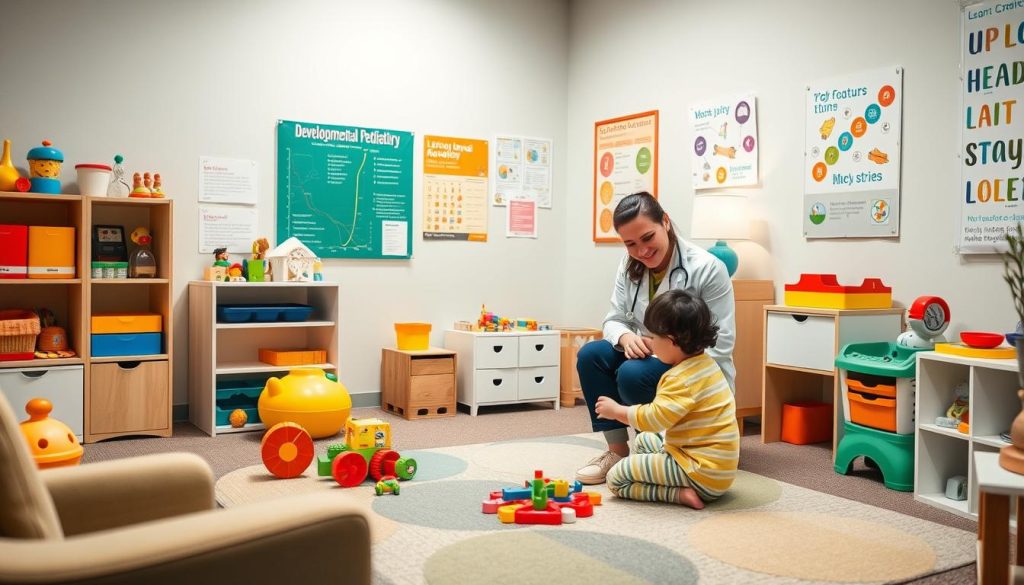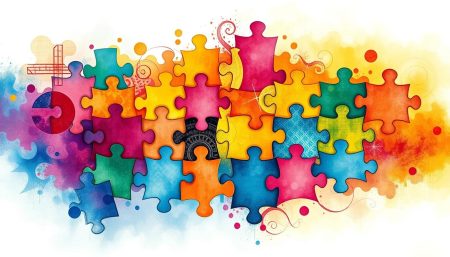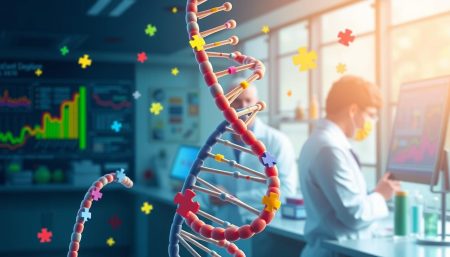The journey of an autism diagnosis process is careful and methodical. It’s vital for families seeking clarity about their loved one’s challenges. This path includes many evaluations and insights into the individual’s behaviors and development. Understanding how to diagnose autism spectrum disorder (ASD) is complex. It involves looking at both obvious and subtle signs. This helps guide the support and intervention needed.
Families starting this journey need a clear guide. The autism diagnosis process shows the important steps from early signs to assessments. Healthcare professionals use their knowledge to understand ASD’s different forms.
With supportive resources and informed care, the process becomes less scary. It turns into a journey of understanding and action.
Initiating the Autism Diagnosis Journey
The journey to diagnose autism often begins at home. Parents or caregivers notice unusual behaviors or delays in their child. Spotting these signs early is key to getting early intervention for autism. This can greatly improve a child’s future and quality of life.
If a child misses developmental milestones or struggles with social interaction, communication, or behavior, it’s time to talk to a healthcare professional. Taking this step can lead to an initial evaluation and possibly an early diagnosis.
- Keep a record of your child’s behavior to share with a healthcare provider.
- See a pediatrician who might send you to specialists in developmental disorders.
- Remember, early diagnosis opens doors to early intervention programs that help a child grow.
Acting quickly is vital in the autism diagnosis process. Identifying autism signs early and getting professional help leads to better results. This can change not just the child’s life but the whole family’s.
Recognizing the Early Signs of Autism in Children
Spotting the early signs of autism in kids is key for early help. Knowing the small hints helps parents, caregivers, and experts figure out how to diagnose autism right.
Identifying Behavioral Flags
There are certain behaviors that point to autism. These include things like rocking, flapping, and being really into certain things. They also show unusual reactions to things like sounds, lights, and touch. Spotting these signs early helps understand a child’s needs better.
Interpreting Social Interaction Cues
Kids with autism often act differently in social situations. They might not look at people, not want to play with others, or have trouble working together. These signs are important for figuring out if a child has autism.
Understanding Communication Challenges
Communication problems are big in autism. Kids might talk late, repeat words, or use words in odd ways. Catching these issues early and helping can really help their development.
Acting fast on these signs can really help kids with autism grow. It’s vital for caregivers to watch for these signs and get help from experts to diagnose autism well.
How to Diagnose Autism Spectrum Disorder
Diagnosing Autism Spectrum Disorder (ASD) is a detailed process. It involves many steps and the help of healthcare experts. They use developmental pediatrician evaluation methods and autism assessment tools. This way, they can spot the different signs of ASD.
Developmental pediatrician evaluation is the first step. Pediatricians with a focus on development can tell if a child has ASD. They talk to parents, watch the child, and work with other doctors if needed.
Autism assessment tools are also key. These tools help gather facts about ASD symptoms. They include watching the child and asking parents questions about their child’s behavior and growth.
| Evaluation Type | Description | Relevance to ASD |
|---|---|---|
| Developmental Screenings | Quick, preliminary tests administered by pediatricians during regular check-ups to detect early signs of developmental issues. | Identifies possible developmental delays that need more checking. |
| Diagnostic Observations | Structured observations using standardized tools like the Autism Diagnostic Observation Schedule (ADOS). | Looks at how the child interacts, talks, and plays. |
| Parental Interviews | Structured conversation with parents to gather detailed developmental history and family dynamics. | Confirms what doctors see by adding real-life examples and family history. |
By combining these steps with the knowledge of developmental pediatricians, diagnosing ASD becomes accurate. This approach ensures each child gets a careful evaluation. It’s important to understand ASD deeply and personally for each child.
Consulting Healthcare Professionals for Autism
The journey through the autism diagnosis process often starts with a visit to specialized healthcare professionals. They can give detailed evaluations and advice on early intervention for autism.
Selecting a Developmental Pediatrician
Finding the right developmental pediatrician is key for an accurate autism diagnosis and guidance. These experts focus on developmental pediatrician evaluation and are vital in suggesting early intervention plans. Here’s what to look for when picking a developmental pediatrician:
- Credentials and experience in developmental disorders
- How they communicate and their approach
- Their views on treatment and intervention
- How easy it is to get to them and their location
The Role of Child Psychologists in Diagnosis
Child psychologists play a big part in the autism diagnosis process. They look into the child’s behavior, emotions, and social skills. Their detailed assessments help figure out if it’s autism or another issue, guiding the need for early intervention for autism.
When to Seek a Neuropsychologist’s Expertise
Neuropsychologists focus on cognitive functions, which are key to understanding a child’s brain. Their insights are great for creating a custom intervention plan that meets the child’s unique needs.
| Specialist | Role in Autism Diagnosis | Focus Area |
|---|---|---|
| Developmental Pediatrician | Initial evaluation and coordination of care | Overall developmental health |
| Child Psychologist | Behavioral and emotional assessment | Behaviour patterns and social interactions |
| Neuropsychologist | Detailed cognitive function analysis | Brain behavior relationships |
Comprehensive Evaluation: The Developmental Pediatrician Assessment
Diagnosing autism spectrum disorder is complex. A developmental pediatrician plays a key role. Their assessment is vital for a thorough understanding of autism.
Steps in the Pediatric Evaluation Process
The process starts with a clinical interview. Parents share their child’s developmental history and concerns. Then, the pediatrician observes and interacts with the child.
They assess the child’s behavior and social skills through various activities. Standardized tools may also be used to gather data. This data is compared to autism criteria.

Physical Examination and Medical History Review
The physical examination is important. It helps rule out other conditions that might look like autism. The pediatrician performs a detailed medical evaluation.
This includes a neurological examination to check motor skills and reflexes. Reviewing the medical history is also key. It helps identify genetic or environmental factors that might be relevant.
Importance of Family Medical History
Family medical history is also important. It can show patterns of developmental delays in the family. This might suggest a genetic link to autism.
Identifying these patterns early is vital. It helps in planning interventions and understanding the risk for future siblings.
| Component | Description | Purpose |
|---|---|---|
| Initial Clinical Interview | Discussion with parents about developmental history and behavioral concerns. | To gather foundational information and parental perceptions of development. |
| Observation and Interaction | Direct interaction with the child, observing behavior in different settings and situations. | To assess the child’s natural social and communication skills and behavior. |
| Use of Standardized Tools | Employment of diagnostic tools like ADOS (Autism Diagnostic Observation Schedule). | For a reliable, standardized assessment of autism-related behaviors. |
| Physical Examination | A detailed medical and neurological examination of the child. | To rule out other conditions that could affect development or behavior. |
| Family Medical History Review | Evaluation of developmental and behavioral patterns in the family. | To identify genetic or familial patterns that could influence the diagnosis. |
Diving Deeper with Autism Assessment Tools
Diagnosing autism spectrum disorder is getting more precise. Specialized tools are key to making accurate diagnoses. These tools help ensure people get the right help tailored to their needs.
Standardized Autism Diagnostic Instruments
The Autism Diagnostic Observation Schedule (ADOS) and the Autism Diagnostic Interview-Revised (ADI-R) are top choices. They help evaluate autism in detail. These tools have greatly helped us understand and diagnose autism spectrum disorder.
Observational and Interactive Assessment Practices
Observation is a big part of autism assessment. It involves a professional interacting with the person being tested. This interaction is key to spotting autism.
Utilizing Checklists and Behavior Rating Scales
Checklists and behavior rating scales make assessing autism symptoms easier. They help systematically look at autism traits.
| Tool | Function | Use Case |
|---|---|---|
| ADOS | Observation of social and communication behavior | Used in clinical settings for a full assessment |
| ADI-R | Semi-structured interview for caregivers | Helps gather detailed developmental history |
| Behavior Rating Scales | Assessment of behavior patterns | Used by educators to track behavioral changes |
These tools are vital for a clear view of an individual’s strengths and challenges. They guide the diagnostic process to more accurate autism spectrum disorder identification.
Collating Information from Autism Screening Questionnaires
Assessing children for autism often starts with an autism screening questionnaire. These tools quickly spot kids who might need a closer look for autism spectrum disorders (ASD).
The Modified Checklist for Autism in Toddlers (M-CHAT) is a key autism screening questionnaire. It’s known for spotting early signs of ASD in young kids. Doctors use it to decide if a child needs more tests.
Let’s look at the types of autism screening questionnaires and their role:
- They’re used at well-child check-ups.
- Follow-up screenings are done if more tests are needed.
- They’re often done in stages, sometimes months apart, to track signs of autism.
These screenings are key for spotting autism and tracking a child’s growth. Doctors count on them to decide on more tests.
Knowing what these questionnaires show helps teachers and therapists. They can then tailor plans to meet each child’s needs. This makes the autism screening questionnaire very important in early help.
Autism is hard to diagnose, but autism screening questionnaires help at the start. They find signs that need a closer look. This helps catch autism early and support kids’ development.
Understanding the Autism Diagnosis Criteria
Getting an accurate autism diagnosis is key for effective treatment. The DSM-5 sets clear criteria for identifying autism spectrum disorder.
DSM-5 Criteria for Autism Spectrum Disorders
The DSM-5 has specific rules for diagnosing autism. It focuses on two main areas: social skills and repetitive behaviors. To be diagnosed, a person must show:
- Challenges in social communication and interaction in many situations
- Repetitive behaviors, interests, or activities
Clinical Threshold for an Autism Diagnosis
Figuring out if someone has autism involves looking at how severe and consistent their symptoms are. The severity level affects the support needed. Here’s how the DSM-5 breaks down severity levels:
| Severity Level | Social Communication | Restricted Behaviors |
|---|---|---|
| Level 1 – Requiring Support | Noticeable deficits in communication skills noticeable during social interactions | Inflexibility of behavior causes notable interference in one or more contexts |
| Level 2 – Requiring Substantial Support | Marked deficits in verbal and nonverbal social communication skills | Behavioral inflexibility and repetitive behaviors appear frequent and severe |
| Level 3 – Requiring Very Substantial Support | Severe deficits in verbal and non-verbal communication | Behavior severely limits functioning, distress/change triggers extreme responses |
Knowing these criteria is vital for a correct autism diagnosis. It helps tailor the right support. Following the DSM-5 criteria ensures accurate diagnosis and effective support.
Early Intervention for Autism: Strategies and Importance
The role of early intervention for autism is huge. It’s key to spot the signs of autism in children early. Starting help right after a diagnosis can change a child’s life for the better.
Benefits of Prompt Autism Support
Early help for autism boosts kids’ skills in many areas. This includes thinking, social skills, and talking. Early support helps kids do better in school and with friends. It also helps kids use their strengths.
Types of Early Intervention Therapies
Many therapies are important in early intervention for kids with autism. Key ones are:
- Behavioral Therapy: Helps kids learn good social, communication, and behavior skills
- Speech Therapy: Works on improving language and talking skills
- Occupational Therapy: Helps with daily tasks and feeling
- Physical Therapy: Boosts motor skills and balance
- Play Therapy: Teaches social skills through play
Family Support and Resources
Family support is key in managing autism. It helps in using early intervention strategies. From knowing the signs to daily help, families are very important.
| Resource | Description | Access Point |
|---|---|---|
| Parent Training Programs | Teaches parents how to help their kids with specific techniques | Local health departments and autism groups |
| Education Materials | Books and guides on autism and how to help | Online and libraries |
| Support Groups | Offers emotional support and advice for families with autism | Community centers and online forums |
With the right early intervention for autism and family support, kids can do well. They get the help they need to thrive.
Navigating the Emotional Aspects of an Autism Diagnosis
The journey through the autism diagnosis process brings a mix of emotions for those diagnosed and their families. It’s important to face and deal with these feelings to build strength and find ways to cope.

Learning about autism through the autism evaluation checklist and diagnosis can make people feel unsure and worried. Families might worry about what the diagnosis means for their loved one’s future. But, with the right support and facts, these worries can turn into acceptance and positive steps.
- Educational Resources: Use available info to learn more about autism and what the diagnosis means.
- Support Networks: Join community groups or online forums to share experiences and strategies with others.
- Professional Counseling: Getting help from autism specialists can help manage emotional challenges.
- Personal Reflection: Take time to adjust emotionally and intellectually to the diagnosis.
Building resilience is key. Focusing on the strengths of the person with autism and accepting their unique view of the world can lead to positive outcomes for everyone.
| Phase | Emotion | Action |
|---|---|---|
| Initial Reaction | Confusion, Shock | Seek accurate information, professional help |
| Adaptation | Anxiety, Concern | Engage with support networks, educational workshops |
| Acceptance | Understanding, Advocacy | Embrace individuality, advocate for awareness |
Keeping a healthy emotional state helps in supporting and advocating for others. This ensures the autism diagnosis process leads to a supportive and understanding environment for growth and development.
The Autism Evaluation Checklist Explained
To spot signs of autism, a detailed autism evaluation checklist is key. It’s used during a check-up by a developmental pediatrician. This tool helps doctors accurately assess behavior, communication, and social skills.
Key Components of the Checklist
The checklist covers important areas like communication, social skills, and repetitive actions. It helps doctors collect the right data for a precise diagnosis.
Relative Contributions of Observations and Reports
Observations by caregivers and self-reports are vital. They help confirm behaviors seen during the check-up. They also give a full picture of a person’s strengths and challenges.
| Checklist Component | Observed by Professionals | Reported by Caregivers |
|---|---|---|
| Communication Skills | Yes | Yes |
| Social Interactions | Yes | Yes |
| Repetitive Behaviors | Yes | Yes |
To learn more about the diagnosis process, check out this link. It talks about ADHD symptoms, diagnosis, and treatment. It’s important for understanding and managing these conditions.
Special Considerations for Girls and Autism Diagnosis
Girls with autism need a special approach to understanding. Traditionally, signs of autism were seen the same in all kids. But, research now shows autism can look different in girls. This means symptoms in girls might be harder to spot and treat.
Understanding Gender Differences in Presentation
Girls with autism might not show obvious signs like boys do. They might be better at acting out social cues. This can make it hard to see if they have autism.
So, many girls might not get diagnosed until later. Or, they might not get diagnosed at all.
Challenges in Recognizing Autism in Females
Girls with autism face big challenges in getting diagnosed. Society’s expectations and stereotypes can hide their signs. Doctors might miss important clues because they don’t fit the usual boy signs of autism.
Girls also use special strategies to hide their struggles. They might seem to fit in better in social situations. This makes it harder to see if they have autism.
The Role of Genetic Testing in the Autism Diagnosis Process
Looking into the genetic causes of autism spectrum disorder has brought new tools to doctors. Genetic testing for autism is a big step, changing how we see and treat the disorder. This part talks about what this testing reveals and how it helps in healthcare.
Genetic testing helps doctors by finding certain genetic changes linked to autism spectrum disorder. Not every autism case is caused by genetics, but this testing is useful for complex cases. It helps when other methods don’t work.
- Clarifies the genetic contributions to autism
- Identifies possible genetic syndromes that show symptoms like autism
- Helps families and doctors make better choices for treatment and care
Adding genetic testing for autism to diagnosis helps confirm it and understand it better. This leads to treatments that fit each person’s needs on the autism spectrum.
Genetic findings in autism spectrum disorder also drive research and new treatments. These could lead to better ways to manage autism in the future.
So, using genetic testing for autism in diagnosis is a big step forward. It helps us understand and manage autism spectrum disorder better.
Insights into the Multidisciplinary Approach to Diagnosing Autism
Using a multidisciplinary approach is key to accurately diagnosing autism spectrum disorder. This method not only deepens our understanding of autism. It also makes diagnosing more precise. By combining insights from different healthcare professionals, the diagnosis better reflects the individual’s needs.
Integrating Different Specialist Evaluations
Diagnosing autism spectrum disorder well needs teamwork. Specialists like developmental pediatricians, child psychologists, and speech and language therapists each offer a unique view. Their combined insights help paint a complete and accurate picture of autism’s complex nature.
Coordinating Care Among Health Professionals
It’s important to have specialists work together smoothly. This teamwork ensures all parts of a child’s development are considered. The goal is to create a treatment plan that meets the child’s specific needs, helping them grow and thrive.
Next Steps After an Autism Diagnosis
Getting an autism spectrum disorder diagnosis is a big moment for families. It starts a journey that’s all about each child’s needs. The first step is usually to create an individualized education program (IEP). This program will help with learning and skill growth.
It’s also key to start early intervention for autism. This can greatly improve a child’s future. Interventions might include speech therapy, occupational therapy, or social skills classes. They depend on the child’s challenges and strengths.
Knowing how to find services and support is also important. In the U.S., schools and health services offer many resources. Parents should reach out to local autism support groups and nonprofits for help.
Community advocacy is also vital. Working together with other families and advocates can help improve services. It’s about making sure everyone gets the support they need.
It’s important to keep checking in and adjusting plans after a diagnosis. As kids grow, their needs can change. Regular talks with healthcare providers and teachers help keep plans up to date.
Being open to learning and changing is key. It helps manage the changing needs of autism spectrum disorder. This way, kids get the best support at every stage of their life.
FAQ
Q: What does the autism diagnosis process typically involve?
A: The autism diagnosis process starts with a detailed evaluation. It includes watching the child, talking to the family, and using special tests. These steps help find out if a child has Autism Spectrum Disorder (ASD).
Q: When should parents begin the autism diagnosis journey for their child?
A: Parents should start the autism diagnosis journey early. Look for signs like delayed speech, trouble making friends, or odd behaviors. These signs are important if they show up before a child is three years old.
Q: What are some early signs of autism in children?
A: Early signs of autism include not making eye contact and speaking late. Children with autism might also repeat actions a lot, have trouble with friends, and react strangely to sounds or sights.
Q: How is Autism Spectrum Disorder diagnosed?
A: Doctors diagnose Autism Spectrum Disorder by checking how a child acts and develops. They use special tools and talk to the family to make a diagnosis. Doctors like developmental pediatricians, child psychologists, and neuropsychologists are key in this process.
Q: What role does a developmental pediatrician play in diagnosing autism?
A: A developmental pediatrician is an expert in child development and behavior. They play a big role in finding out if a child has autism. They do detailed checks, talk to the family, and use special tests to make a diagnosis.
Q: What are the steps in a developmental pediatrician assessment for autism?
A: A developmental pediatrician’s assessment for autism starts with a family interview. They review the child’s medical and developmental history. Then, they observe and interact with the child. They also use tests like the ADOS and ADI-R to diagnose.
Q: Which standardized autism diagnostic instruments are used during evaluation?
A: Doctors use the Autism Diagnostic Observation Schedule (ADOS), the Autism Diagnostic Interview-Revised (ADI-R), and the Childhood Autism Rating Scale (CARS) to diagnose autism.
Q: What purpose do autism screening questionnaires serve?
A: Autism screening questionnaires help find children who might need a deeper check for ASD. They help doctors decide if a child should get a full diagnosis.
Q: What are the DSM-5 criteria for Autism Spectrum Disorders?
A: The DSM-5 says a child must have trouble with social communication and interaction. They must also have repetitive behaviors or interests. These signs must be there from early childhood and affect daily life.
Q: Why is early intervention for autism important?
A: Early help for autism can greatly improve a child’s development. It targets key areas like communication, social skills, and behavior. This can lead to better long-term outcomes and independence.
Q: How can families manage the emotional aspects of an autism diagnosis?
A: Families can handle the emotional side of an autism diagnosis by getting support. They can talk to health experts, join groups, and take care of themselves. Building a strong support network is also key.
Q: What is included in an autism evaluation checklist?
A: An autism evaluation checklist looks at social skills, communication, behavior, interests, and how a child reacts to sounds and sights.
Q: What are the special considerations for diagnosing autism in girls?
A: Girls with autism might show signs differently than boys. They might have less obvious social problems and interests. It’s hard to diagnose them because they might hide their symptoms. Doctors need to know these differences.
Q: What is the role of genetic testing in diagnosing autism?
A: Genetic testing can show if there are genetic links to autism. It helps understand the biology of ASD. It can also guide treatment plans.
Q: How does a multidisciplinary approach improve the accuracy of an autism diagnosis?
A: A team of experts working together provides a full evaluation. This team effort gives a better understanding of the child’s needs. It helps make a more accurate diagnosis.
Q: What are the next steps after receiving an autism diagnosis?
A: After a diagnosis, the next steps are to make a plan for the child’s education and therapy. They should also connect with support services. It’s important to keep checking and adjusting the help based on the child’s progress.


















